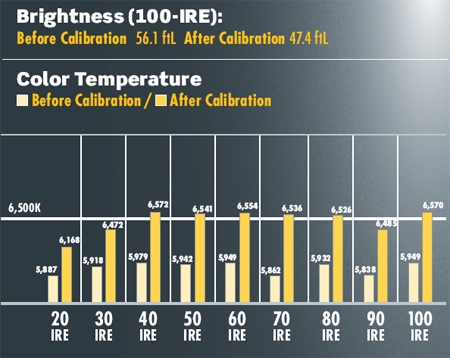Panasonic TC P58V10 58-inch Plasma HDTV Page 3

TEST BENCH
Primary Color Point Accuracy vs. SMPTE HD Standard
| Color | Target X | Measured X | Target Y | Measured Y |
| Red | 0.64 | .63 | 0.33 | .32 |
| Green | 0.30 | .28 | 0.60 | .53 |
| Blue | 0.15 | .158 | 0.06 | .06 |
The TC-P58V10 performed very well on our usual battery of static test patterns and torture-test video clips. With the TV set to the Custom video preset and color temperature set to Warm2, its grayscale tracked quite evenly around 6,000 K, a bit redder than the industry-standard 6,500 K but still very good. This linearity was a breath of fresh air compared with most LCDs I've tested lately, all of which added some degree of color tint to white at the extremes of the grayscale. It took only minor adjustments to the White Balance controls in the Advanced Video menu to bring the grayscale within +/-72K of the standard - excellent results.
Color primaries measured close to the SMPTE spec for red and blue, although green was a touch undersaturated. After adjustments, including turning down the color control a bit to get the most natural-looking picture, the color decoder showed -15% error for red, -5% for green, and 0% for blue. (By comparison, primaries in the THX mode were dead on at the default settings, and color decoding measured -10% red, +10% green, and 0% blue. Default brightness at 100 IRE in THX was 34.1 ftL.)
The set fully and cleanly resolved static 1080i/p and 720p HD signals via its HDMI inputs, though 1080-line signals showed some noise via the component-video inputs. Motion resolution was superb as well, with the TV retaining full 1080-line HD resolution on all the scrolling test patterns on the FPD (Flat Panel Display) test disc - a result I've never seen on any LCD, even those with a 120-Hz refresh rate. These patterns feature various resolution charts that start out motionless and then scroll repeatedly from right to left across the screen, essentially a check of the set's ability to retain clarity when displaying moving objects. On LCDs, it's not unusual to see moving resolution drop to half the number of lines that are visible when the patterns are static. 1080p/24 signals viewed with the Panasonic's 96-Hz or 60-Hz display modes were stable, but the 48-Hz setting produced noticeable flicker. Overscan measured 0% in Full mode with the video menu set to HD Size2 and 3% with the setting at HD Size1. Full-field gray test patterns revealed the near-perfect screen uniformity typical of plasma TVs, which are self-illuminating and have no backlight. The Panasonic also demonstrated the wide viewing angle typical of plasmas. Its glossy screen was about my only concern - despite some Panasonic technology applied to alleviate glare, it still definitely showed reflections on dark areas of the picture when subjected to direct bright light. But even with the overhead lights on, reflection was only visible momentarily on those portions of the image that went dark, so it tended not to be distracting.
The TC-P58V10 aced all the torture tests on the HQV Blu-ray and DVD discs, demonstrating excellent deinterlacing of both HD and standard-def signals. The video noise clips on the DVD version revealed some weakness in the Panasonic's ability to suppress random video noise on standard-def programming, and the set's noise-reduction modes did little to help here other than subtly soften the image. Fortunately, these clips are extreme examples, and in day-to-day viewing the TV presented a stable and relatively noise-free image with standard-def TV broadcasts and DVDs.













































